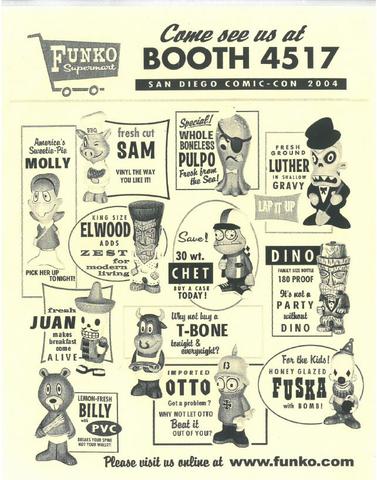
When a small team of pop culture enthusiasts led by Funko founder Mike Becker first started the Fantastik Plastik line in 2003, their chief purpose was not to take the toy industry by storm or develop a multimillion dollar company, but to entertain themselves. At the time, Funko had a reputation as a nostalgia company, shaped by hot rod culture, Rat Fink, all things tiki, the ‘50s and ‘60s and ad icons. In those days, toy companies focused on producing their own original characters rather than licensing another brand's characters and stories.
“Mike Becker would have us do tons of these drawings and we would just do whatever we wanted, left-field stuff, and then we'd put them up on the wall. Sometimes Becker picked ones we liked, sometimes he picked ones just because they were weird, like Billy,” recalled Rob Schwartz, Senior Environment Designer.
Among the earliest designs was Billy the Beaver, an anthropomorphic beaver holding a stick of wood and wearing golden underpants. Schwartz and Senior Art Director Sean Wilkinson helped develop the esoteric humor that characterized the Fantastik Plastik line and early Funko brand. Underpants played a vital role in Funko's early aesthetic and history.
“That was the sense of humor and it was fun to make it and go ‘I wonder if somebody's going to buy this,'” said Sean. “Underpants were on our shipping boxes. Chicken legs and underpants and pizza and odd things.”
Then there were the Golden Underpants Awards conferred on the most enthusiastic Funko fans—known as Funatics. “I remember this sunny day. I was outside just laughing as we spray painted tighty whities gold and sealing them in frames to give out to these Funatics,” Schwartz recalled with a laugh. “When Brian took over the company I go, ‘It's kind of part of the tradition.' He goes, ‘Well, that's ending. I'm sorry, I'm just not as into underpants as Becker.'”
“Brian's retired the underpants. We're not feeling nostalgic about the golden underpants around here,” Sean confirmed. “Yet. But there's still time.”
The earliest Fantastik Plastik characters included monsters with piercing fangs, animals holding packaged meat, skeletons wielding maracas and sombreros influenced by Schwartz's Mexican heritage and a suave tiki figure wearing a fez and clutching a martini. There was no rhyme or reason to any of it, beyond celebrating the creators' personal interests, hobbies and humor. The characters were misfits—leering, unnerving and utterly unique.
At the time, inexpensive production techniques were essential for the young company and the cheapest method of making the Fantastik Plastik figures was a technique called blow molding, also known as spin casting. The blow molding technique involves a single piece mold which has plastic poured into it. The plastic solidifies and the figure is pulled out while it's still wet, requiring the figure to be sufficiently flexible that it won't break or snap during the removal process. To fit in the mold, the characters' arms must be close to the body, there's no space between the characters' legs and no space to accommodate extraneous details. Adding additional molds and pieces increases the cost, and during Funko's earliest years increased costs simply weren't an option.
“It was a real limitation to how we put these things together but that was part of the charm, I think,” Sean recalled.
But everyone involved in those early days, including the fans, agrees that where Funko's sense of humor truly shined was the packaging. Jacob "Rev" Telles, known even among dedicated Funatics as an intense collector, encountered his first Fantastik Plastik figures in an FAO Schwarz store in Las Vegas. The collectibles were behind glass, leading Jacob to conclude that they must be expensive. When he discovered the price, he decided to purchase three—Otto, Dino and Luther.

“I didn't even know it was Funko. I didn't know what Funko was at the time,” Jacob admitted. “I was not a collector. As a kid, I collected coins but in general I'm not the type of guy that collects things. I wasn't that guy.”
But the characters captured the essence of Jacob's favorite communities and interests. Jacob loves to travel the country attending rockabilly and punk shows. He estimates that it was 15 years ago that he first encountered those three Fantastik Plastik figures. Today, Jacob owns every Fantastik Plastik collectible ever made, as well as more than half of the prototypes and original artwork and notebooks. Jacob is a big fan of custom culture and the Fantastik Plastik packaging spoke to the level of thought, consideration and humor invested in the products.
Sean calls the poems, messaging and artwork that adorned the product packaging irreverent and weird. “It was fun and that was in the days when we didn't have such a huge toy line that we could spend a week on a cool package and finesse it and hand paint artwork for it,” he said. “We got to be really artsy and kind of old school with it and it was a lot of fun to do that. When the whole spotlight of the world of toys isn't on you, you can get away with things.”
“If you have really early Funko products, if you read the bottom where it says Made in China, there was often some kind of bizarre in-joke that won't make any sense to you,” added Rob.
Becker and the team would use the packaging to write poems, private jokes and messages to fans. During one particularly memorable Comic Con the Funko booth was supermarket themed and the Fantastik Plastik character Pulpo was wrapped in supermarket meat packaging inside a refrigerator case.
Around the mid-2000's the Fantastik Plastik line was cancelled as Funko evolved into a more modern company with new lines, leaving Rob and Sean with notebooks full of characters never brought to life. They'd wanted to do a caveman character and had never struck on the right design.
But Jacob wasn't ready to let go of the line. Over the course of his quest to acquire every Fantastik Plastik character across every colorway, Jacob stumbled across the Funatics community online and he eventually started collecting Freddy Funko figures as well. Several years ago, Funko CEO Brian Mariotti reached out to the Funatic community offering tickets to Comic Con. Jacob decided to take Brian up on this offer despite his concern that he might not fit in with the crowd. His interests—rockabilly, music and the old school Fantastik Plastik line—seemed incompatible with the superhero-obsessed Funatics Jacob expected to meet.
“Some of those people are my best friends today,” Jacob revealed. “I think the best way to describe it is you come for the toys and you stay for the people. It's the truth. I still enjoy collecting but it's about me going to see my friends. I've been to two weddings because of Funko. I was the best man in one in Canada. All because of a toy. All because of a $10 toy.”

Jacob used his time at Comic Con productively, encouraging Brian to revive the Fantastik Plastik line. He believed that reimagining the Fantastik Plastik characters through the Pop! lens would create a bridge between the old and new collectors. Eventually Brian agreed. Rob and Sean are thrilled to see some of their earliest work representing Funko's charmingly quirky, kitschy past get some respect in the modern era and even more excited to see what the Fantastik Plastik line will look like with the company's resources and talent pool.
When the Fantastik Plastik line first launched, distribution was extremely limited, making it difficult to get the collectibles in the hands of the people who would most appreciate them. It was pure luck that Jacob found the line of collectibles that so resonated with his interests that fateful day at FAO Schwarz but Funko in its modern incarnation has the necessary distribution to get the new Fantastik Plastik line into the hands of anyone who might have an appreciation for the newest round of misfit and weirdo characters.
“I hope we still have some weird fans,” Rob said. “When I think of the combined firepower of some of the artists we have here, it could be great.”

Rob, Sean and Jacob know that the Fantastik Plastik line will likely have a select fandom, but Fantastik Plastik always had a select but highly appreciative fandom. Rob recalls cosplayers attending conventions dressed as Fantastik Plastik characters—a flattering, if unexpected, turn of events. The characters still turn up on back decks at old car shows. And everything old eventually becomes new again, fashions fade and revive, supporting the hope that the new Fantastik Plastik line will resonate with audiences both new and retro.
“We'll get that caveman yet,” Sean concluded.
“And maybe one of them will even have golden underpants,” Rob added.











 Items in your cart may be affected with updated location.
Items in your cart may be affected with updated location.




































